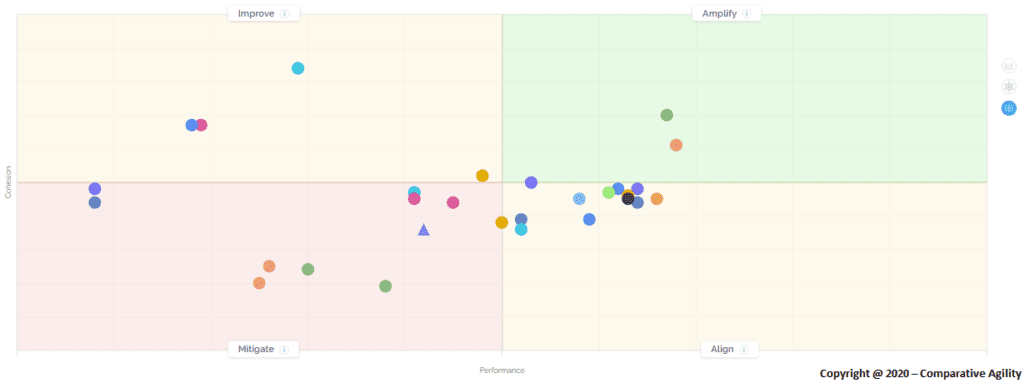This post is part of an ongoing blog series where Scaled Agile Partners share stories from the field about using Measure and Grow assessments with customers to evaluate progress and identify improvement opportunities.
As organizations move from team-level agile to enterprise agility, predictive analytics and statistical insights play an increasingly important role in improving how organizations operate. Gartner predicts that this year, AI will create 6.2 billion hours of worker productivity globally, resulting in $2.9 trillion of business value. The rationale for this increased focus on data-driven insights is clear: while business environments continue to grow more complex and uncertain, the need for fast decision-making and agility has never been greater.
By identifying potential problems before they become organizational challenges and applying proprietary algorithms to large amounts of data, we can identify patterns and direct organizational attention where it matters. But the insights must be shared in a way that helps change leaders improve their decision-making.
To make complex statistical analysis useful, it should be presented in a way that inspires action.
The Impact Matrix: Measuring performance and cohesion
This challenge is the motivation behind the Impact Matrix, a canvas that immediately identifies how teams are doing based on two essential vectors of team potency: performance and cohesion. Getting an understanding of teams helps change leaders quickly recognize challenges, prioritize efforts, and develop improvements.
Let’s take a closer look at a sample Impact Matrix report and explore how it can accelerate an organization’s transformation efforts.

As illustrated in this example, the teams (represented as dots) in an organization’s portfolio are positioned on the canvas based on their relative score across two vectors; performance and cohesion.
Depending on a respective team’s score and relative position, we can quickly identify a theme of focus, categorize a strategic approach, and pinpoint essential questions that leaders should consider when deciding next steps.
Amplify: High performance, high cohesion (green zone)
Teams in the Amplify quadrant are performing at a relatively high level and there are no major disconnects between the team members. Organizations benefit from observing these teams, understanding what makes them perform consistently, and trying to amplify these norms across the broader organization. Some helpful questions to ask include, “To what degree is the environment enabling teams to perform at this level?” “What role does management play in empowering these teams to do so well?” and, “How can coaching help these teams sustain—and even exceed—their current levels?”
Align: High performance, low cohesion (yellow zone)
When teams are in the Align quadrant they are performing well, but there are significant disagreements and disconnects between team members. Organizations benefit from keeping a close eye on teams in this quadrant, as a lack of team cohesion is a leading indicator of deteriorating performance. Questions to consider for teams in this context include, “Are certain team members dominating conversations?” “Is there sufficient psychological safety so all team members can feel comfortable speaking up?” and, “Is there a clear purpose that team members can rally around?”
Mitigate: Low performance, low cohesion (red zone)
Teams in the Mitigate quadrant are indicating they need help: they’re not only performing poorly, but they’re also disconnected. Organizations benefit from listening to and engaging with these teams to help alleviate their challenges. Questions that may be helpful in this context include, “What are immediate actions we can take to ease the current situation?” “How can we better understand why the team feels challenged?” and “How can the organization give the team a safe environment to work out challenges?”
Improve: Low performance, high cohesion (yellow zone)
Teams in the Improve quadrant usually don’t remain there for long. These teams are performing relatively poorly, but they’re aware of their challenges—and typically, they take steps to improve their situation. Organizations benefit by helping these teams accelerate their improvement efforts and providing them with the necessary resources. Questions these teams should ask include, “What steps can the team take to start alleviating current challenges?” “How can the organization help?” and, “What insights do the data give us about where to start?”
Conclusion
By leveraging data and sophisticated analytics, the Impact Matrix helps change leaders accelerate their transformation efforts by focusing their work where it matters, pointing them in the right direction, and ultimately supercharging their ability to lead organizational change. Although data and meaningful analytics are insufficient to give you all the answers you need, they can help you ask better questions and complement your overall transformation strategy.
Do it yourself: Run the Impact Matrix on your release train or portfolio today to get a comprehensive picture of how teams are performing, and find out immediately where you can provide the most value to your organization. Activate your free Comparative Agility account on the SAFe Community Platform.

Matthew Haubrich is the Director of Data Science at Comparative Agility. Passionate about discovering the story behind the data, Matt has more than 25 years of experience in data analytics, survey research, and assessment design. Matt is a frequent speaker at numerous national and international conferences and brings a broad perspective of analytics from both public and private sectors.
Share:
Back to: All Blog Posts
Next: How 90 Teams Used Measure and Grow to Improve Performance by 134 Percent